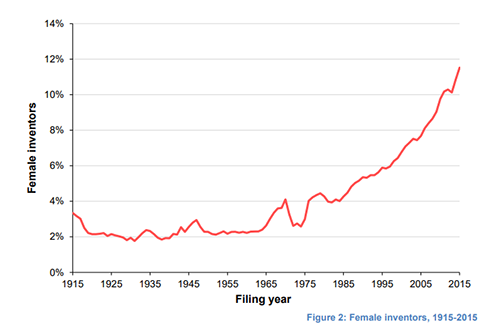A new member will be joining the Mr Men and Little Miss series, and we couldn’t be happier with Adam Hargreaves’ choice of character. Little Miss Inventor, whose book is being released to coincide with international women’s day, is a female engineer and has been created as a “positive role model” for girls.
Described as “intelligent, ingenious and inventive”, Little Miss Inventor certainly seems to represent a more captivating role model for girls than her companions Little Miss Sunshine and Little Miss Sparkle who – while undeniably having positive qualities – appear less ambitious.
As a woman working in science, I’m personally delighted to see the addition of a female Little Miss character with a scientific focus. More role models are needed to overturn gender stereotypes and inspire young girls to pursue, and be excited by, science.
Little Miss Inventor’s arrival shines the spotlight on female inventors. We’ve reviewed a 2016 report from the UK Intellectual Property Office (UKIPO) on Gender Profiles in Worldwide Patenting to see just how unusual Little Miss Inventor is, and to assess whether she’s a product of a prevailing change in gender profiling of inventors, or a tool needed to instigate change. Although the report relies on inferencing gender from the inventors’ first names (it is not a legal requirement to provide an inventor’s gender), and further is limited to binary genders, it is the most comprehensive review of gender in patenting to date.
The past 100 years
The below table from the UKIPO report shows the annual percentage of female inventors on all published patent applications between 1915 and 2015. Clearly the proportion of female inventors has increased dramatically in the past 100 years (from a low 2-3% in the first half of the 20th Century, to 11% in 2015). Although this is a dramatic improvement, the absolute numbers are still low – even today only around 1 in 9 named inventors is female.
Interestingly, there is a turning point around 1975, and since then the proportion of female inventors has been steadily increasing. If the proportion of female inventors increases at the same rate as the last 40 years, it will take until the year 2198 to achieve an equal proportion of female and male inventors. We all should be doing more to accelerate this increase.

source: https://assets.publishing.service.gov.uk/government/uploads/system/uploads/attachment_data/file/567518/Gender-profiles-in-worldwide-patenting.pdf
Multiple inventors
Because each application can have multiple inventors, reviewing the data on a per application basis sheds a different light on things. Using this analysis, patents fall into five possible categories (female team, female individual, male team, male individual, mixed team), illustrated in this pie chart of the inventor types on patents filed in 2014.
The percentage of applications involving a female inventor in 2014 is almost 27%, having risen from 5% in 1975. Clearly this marks huge progress; but looking more closely at the numbers gives, perhaps, a somewhat less promising view for the following reasons:
1. The percentage of applications naming at least one woman is 26.8%, however the percentage of applications naming only female inventors is 4.8%. Therefore, in the vast majority of cases, if a woman is named as an inventor on an application, it will be as part of a team of men.
2. The percentage of all-female teams is 0.28%. This is vanishingly small, reflecting just how few women-only teams exist in innovation.
3. 96% of applications name one or more male inventors. That means 19 out of 20 applications involve at least one male inventor. It is, therefore, no surprise that being an inventor is seen to be a male occupation.
Hope for the future?
How large is the worldwide gender gap in named inventors? Pretty large. Are things getting better? Yes. Are things getting better fast enough? No. The current rate of change will take until almost 2200 for the number of named male and female inventors to be equal.
Little Miss Inventor indicates a welcome change in attitude towards women in science and brings hope that the next generation of girls will be inspired to become inventors. We’d like to think that steps like this will catalyse the increase of female inventors.
Female inventors have brought us a wealth of incredible inventions, from the aquarium (Jeanne Villepreux-Power in 1832) to the first universal programming language COBOL (Grace Hopper, 1952); even to “frequency hopping” which provides the foundation for GPS, Bluetooth and Wi-Fi (Hedy Lamarr with George Antheil, 1942). Who knows what clever and wonderful things a new army of female inventors will invent?
Little Miss Inventor is not a perfect solution, not least because the words “Little” and “Miss” are hardly empowering, however with a bit of luck young girls will focus on the more important word: “Inventor”. Little Miss Inventor can indeed be a positive role model for girls to identify with. After all, she too inhabits a male dominated world, aptly named Misterland, where the most widely known and celebrated characters are men – and yet she pursues her inventor dreams nonetheless. We hope that Little Miss Inventor is the first in a very long line of new female inventors.
This article was written by Emily Collins. We are grateful to Mr Men for letting us use their image and for their excellent choice of character.